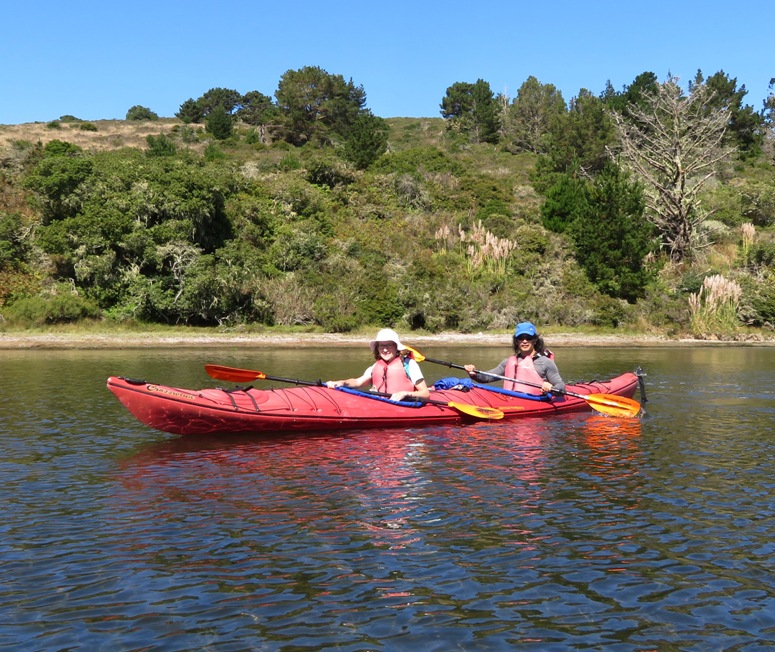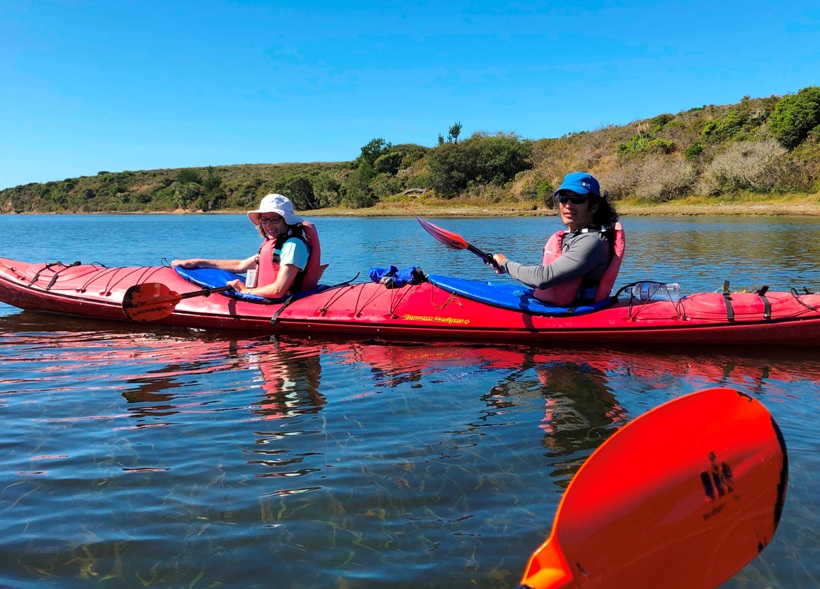Whenever we travel to someplace warm, I like to get out on the water at least once if possible. This trip was no exception.
My cousin Alex took the day off and joined us for the day. The three of us went kayaking at
Drakes Estero, an expansive estuary in the
Point Reyes National Seashore of
Marin County, California.
We arranged a guided tour through
Point Reyes Outdoors. The last time we did a trip through them was at
Point Reyes with my folks on
August 1, 2008. Outfitter companies don't usually last so long so they must be doing something right.
The following is our Drakes Estero trip description provided by the outfitter:
On this wonderful tour we will kayak into the heart of one of the last pristine estuaries on the California coast. Drakes Estero, protected by the Point Reyes National Seashore, is a 160-acre tidal salt marsh which supports highly diverse plant and animal life. Wildlife encounters with harbor seals, bat rays, leopard sharks and an array of migratory and resident birds are common.
It was a long drive and traffic was heavy at times. Fortunately, we left early and gave ourselves plenty of time to get there. Norma and I arrived early, which was fine because it was a nice place to explore on foot.
Here is a view upstream of where we launched at Drakes Estero at
38.085972, -122.932500. We didn't paddle this part but I'm sure it would have been fun, especially on a SUP.
I explored the cliffs near our launch site and found several dew-covered spider webs.
Here is where we launched, a beach looking south to
Schooner Bay. We got an early start so the water was calm. In the afternoon, the winds typically pick up. If you head out there, be forewarned that there is no cell phone service as of 2019.
Out on the water, we saw several
white pelicans near
Bull Point. There were also sea gulls, cormorants, and brown pelicans (which are smaller) but the white pelicans were the main attraction.
I believe this is a
Long-billed Curlew.
Here's Alex with our guide, Ian. Ian took good care of us and knew where to take us to see plenty of wildlife. He also made suggestions of where to hike after kayaking.
Here's Norma and me in a Current Designs Crosswind plastic tandem kayak.
1 / 2


In tandem.
2 / 2


Side view.
❮
❯
We probably saw a couple dozen
leopard sharks.
We also spotted one
bat ray which Alex spotted. The sharks were up to five feet long and the bay ray was about 18 inches across.
According to a park sign,
Bat rays are common in Drakes Estero, Bolinas Lagoon, and Tomales Bay. These areas serve as critical nursery and feeding spots where the rays forage on crabs and other invertebrates. When they forage, rays dig large pits that are up to 12 feet wide and 6-8 inches deep, which in turn provides habitat for other species.
The sharks moved pretty fast so it was often difficult to get a good look at them but we could definitely see their spots which give them their name.
I would like to return here on a really calm day on a SUP to get better pictures of the leopard sharks. I've been kayaking for over 20 years and this was the first time I'd ever seen a shark while paddling. It was a great experience!
Most of the leopard sharks were on the west side of
Home Bay at
38.068389, -122.923722. Make sure to visit when the tide is high.
The area was full of aquatic vegetation including something that Ian called
elephant snot but I don't believe this is it.
Ian also spoke about
lichens which was growing on the shore. He explained that it is a dual organism, something I did not know.
Here's more aquatic vegetation.
The water was fairly clear...about the same as the cleaner parts of the
Chesapeake Bay if it hasn't rained for awhile.
I enjoyed talking with Ian. He and his girlfriend are quite adventurous and live a lifestyle that I envy though I don't think I'd be quite as comfortable as them with a "live for today" outlook versus "plan for tomorrow." Then again, maybe they are much better prepared for tomorrow than what things appear. And perhaps I will die soon after writing this and, in the afterlife, regret having worked so long in a windowless office.

